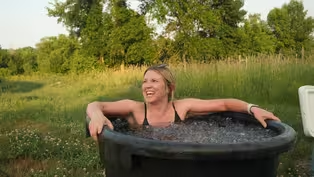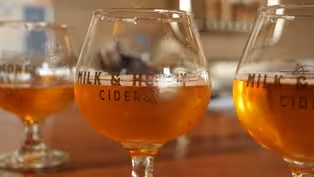
Nora Taksdal - Syttende Mai
Clip: Season 15 Episode 3 | 11m 50sVideo has Closed Captions
Nora Taksdal shares her thoughts on Syttende Mai in Norway.
Nora Taksdal shares her thoughts on Syttende Mai in Norway.
Problems playing video? | Closed Captioning Feedback
Problems playing video? | Closed Captioning Feedback
Postcards is a local public television program presented by Pioneer PBS
Production sponsorship is provided by contributions from the voters of Minnesota through a legislative appropriation from the Arts and Cultural Heritage Fund, Explore Alexandria Tourism, Shalom Hill Farm, Margaret A. Cargil Foundation, 96.7kram and viewers like you.

Nora Taksdal - Syttende Mai
Clip: Season 15 Episode 3 | 11m 50sVideo has Closed Captions
Nora Taksdal shares her thoughts on Syttende Mai in Norway.
Problems playing video? | Closed Captioning Feedback
How to Watch Postcards
Postcards is available to stream on pbs.org and the free PBS App, available on iPhone, Apple TV, Android TV, Android smartphones, Amazon Fire TV, Amazon Fire Tablet, Roku, Samsung Smart TV, and Vizio.
Providing Support for PBS.org
Learn Moreabout PBS online sponsorship(marching band music) (people chatter indistinctly) - [Interviewer] How do Norwegians feel about their royalty?
- Yeah, you know, they say it's very hard to be a Republican in Norway because the royal family is very popular, and they're very good at balancing their kind of noblesse with being really down to earth, and our king has an enormous sense of humor.
(slow electronic music) So I am Nora Taksdal.
Of course, lots of people think it's weird to inherit this role, you know, to be born into it, but actually, the grandfather of the present king, he was a very, very important symbol during the war, Second World War, not only a symbol.
I mean, he was leading military troops from England, and he was actually the one who really said no to capitulate to the Germans whereas lots of politicians wanted to cooperate and kind of obey the Nazis.
So he became a very strong symbol for Norwegian unity.
And usually, I could have gone just down there and uphill, but now they have closed the whole access to that street, and here is the castle again, and now you see the king's guards.
So they're coming up there, and they will have a busy day tomorrow.
(slow electronic music) (door opens) Yeah, so now I changed into the bunad that I got for my confirmation because tomorrow is the 17th of May, which is the big national day of Norway where we celebrate our constitution.
(slow electronic music) So the Seventeenth of May, it's called Syttende Mai.
Yeah, I guess it's maybe like 4th of July.
It's kind of a phenomenon, and we celebrate our constitution that we got in 1814, but at that time, we are in union with the Swedes.
It's a long story, but we actually had a referendum.
When we became independent in 1905, we left the union with Sweden, and they appointed a Danish prince to become the new king of Norway, and he insisted on having a referendum to see if the Norwegians wanted republic or monarchy, and by far, the answer was the monarchy.
- Really?
- So we have a kind of chosen king, you know, even if it's very long ago now.
So I think more and more, people in Norway are kind of principally for republic, but still, I mean, they're the- - It's nice.
- The royal family and the king, they're so popular.
So as long as it works, I don't think that will change it.
If some of the kings or queens start to behave in the wrong way, I think their days will be counted, you know?
(interviewer chuckles) But, of course, in Oslo, we are very proud to have the royal castle and the royal family who will stand on their balcony and greet all the people in the procession.
(marching band music) (people chatter indistinctly) I am the principal viola player in the Norwegian Radio Orchestra.
And I have lots of colleagues, brass players or percussionists who have had their service in the King's Guards Band.
(marching band music) Yeah, I think it's a bit funny because lots of foreigners and lots of immigrants, they say that the Seventeenth of May is actually the least Norwegian day because Norwegians are pretty homeward bound.
We have a cold climate, so we like to be indoors, but on this very day, everyone is out in the streets, and everyone looks happy.
- Hey!
(people chatter indistinctly) Shake what your flag gave ya.
- You know, the bunad is a costume that we use in the most important ceremonies of life.
When we gained our independence in 1905, we had lots of founding fathers and mothers, of course, who wanted to see what was the typical Norwegian heritage, nature, identity, the qualities, the art, literature, and we had an amazing woman called Hulda Garborg.
She's named the Mother of the Bunad.
At that time, it was the Hardanger bunad that was reckoned as the most national token because of Hardanger, the area with the glaciers and fjords and the Norwegian folk music.
So it was kind of the essence of what we like to consider very Norwegian.
(soft pleasant viola music) And I have a picture of my own grandmother, and when she was only 11 years old, she managed to sew her own bunad.
She has sewn every stitch of it.
She chose the Hardanger bunad to celebrate that Norway was one year old in 1906.
Yeah, I will say that bunads have become incredibly popular.
You will see bunads on everyone, from even dogs (laughs) to babies in the (laughs) prams, and today, it's really very popular and very common to see men in bunads.
There are different kinds and categories of bunads, and they will tell you where a person comes from, but this is the bunad that shows that you are from a coastal area because then we have the blue color, and the same bunad here used to belong to my mother and now my daughter.
It's the same bunad with the black color because it shows that it's from an agricultural area.
I got this for my confirmation.
It's a quite simple design.
It does not have embroidery, for instance, which lots of other bunads do have, but these bands, the woven bands are taken from the Viking graves, from the boats, the big Viking ships where they have found these patterns and these style of bands, and we have these funny things here.
Very interesting for cats, (laughs) and actually, the silver that I wear now is the silver that I got from my grandmother, and it's not really the silver which is common to use with this bunad, but, of course, it's a legacy from the family, so it's absolutely allowed to use something that you have a personal relationship to.
And then just to show a little bit of the variety that we have in the bunads, this is actually a bunad that was designed by a famous Norwegian painter, and this certainly has embroidery.
So it's a big job to make.
(drums pound) (people chatter indistinctly) I just think it's important for me because it's interesting.
We were asking the orchestra when we were celebrating the centennial for the constitution, and we were asked to play in bunads, and two of the colleagues were pretty provoked by it, and that was one Swede and one from Serbia.
But I think it's really important to remind ourselves that the ones who actually created Norway were very kind of mundane people who had deep respect for other people.
So I don't think it's kind of the roots of the nationalism that we'll say that Norway's the best, you know, and we should conquer the world.
It's more kind of a humble idea that the ideals that we want to live for should be shared by all people in the world, you know, freedom and the possibility to have education and a good healthcare system, all these things.
So it's a wide recognition of how we want to live in this small country, I think.
Yeah, you want to film this?
The special storage for bunads is, of course, this.
(speaks in foreign language and laughs) Yeah, and actually, bunad actually means something you live in.
It could be a house or a, yeah, so it says something about how important they are.
You know?
Bunad.
And there is even a zipper in the bottom here.
(bag zips) (soft bright rhythmic music) So here it is.
I have three daughters now who are grown up, and they have been so lucky as to inherit bunads from various relatives, grandmothers, and one from one of my sisters.
But maybe one day if I get grandchildren, it would be a classic thing to give it on to that generation.
I still don't know, but I will definitely decide who is going to get this.
Yeah.
(bright rhythmic electronic music) - [Narrator] "Postcards" is made possible by the Minnesota Arts and Cultural Heritage Fund and the citizens of Minnesota.
Additional support provided by Margaret A. Cargill Philanthropies.
Mark and Margaret Yackel-Juleen on behalf of Shalom Hill Farms, a retreat and conference center in a prairie setting near Wyndham, Minnesota, on the web at shalomhillfarm.org.
Alexandria, Minnesota, a year-round destination with hundreds of lakes, trails, and attractions for memorable vacations and events.
More information at explorealex.com.
The Lake Region Arts Council's arts calendar, an arts and cultural heritage funded digital calendar showcasing upcoming art events and opportunities for artists in West Central Minnesota, on the web at lrac4calendar.org.
Playing today's new music plus your favorite hits, 96.7 KRAM, online at 967kram.com.
(bright soft rhythmic music)
Video has Closed Captions
Clip: S15 Ep3 | 5m 36s | Milk and Honey Cidery brings an exciting flavor to our local landscape. (5m 36s)
Video has Closed Captions
Clip: S15 Ep3 | 12m 20s | Rugged Wellness explores sauna and cold water immersion culture in Minnesota. (12m 20s)
Sauna Culture, Minnesota Cidery, Syttende Mai
Preview: S15 Ep3 | 40s | Rugged Wellness explores sauna and cold water immersion culture in Minnesota. (40s)
Providing Support for PBS.org
Learn Moreabout PBS online sponsorshipSupport for PBS provided by:
Postcards is a local public television program presented by Pioneer PBS
Production sponsorship is provided by contributions from the voters of Minnesota through a legislative appropriation from the Arts and Cultural Heritage Fund, Explore Alexandria Tourism, Shalom Hill Farm, Margaret A. Cargil Foundation, 96.7kram and viewers like you.




















